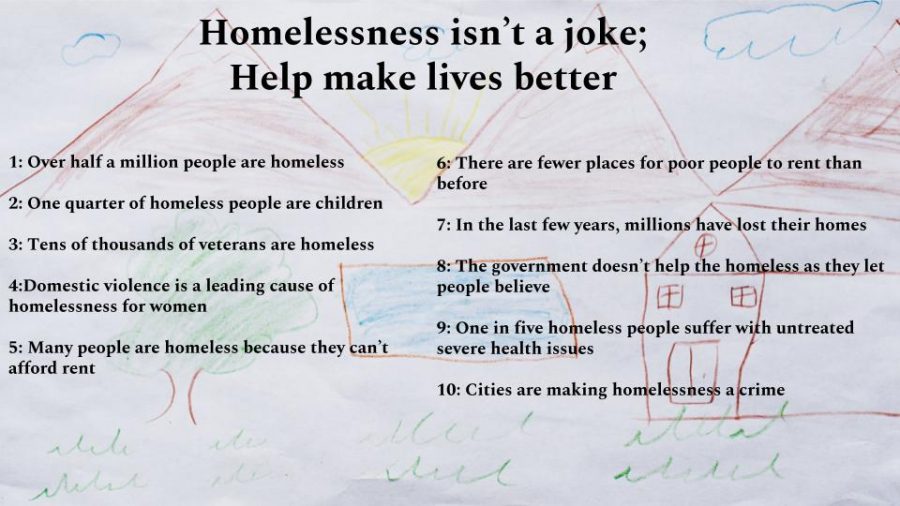How best to help the homeless?
Facts about the Homeless
December 28, 2018
During the holidays, families cozy up by the fire and eat hot meals every night, but not everyone is granted that warm wish. The homeless have a very different experience. How can the community and high school students help the homeless during the colder seasons?
Advocates for Homeless Families is an organization that helps homeless families who don’t have the support and resources to overcome their homelessness.
At schools, churches, and temples, students and teachers participate in canned food drives donated to local food banks. Also there is is a clothing drive where people can bring in old clothes they don’t want and give them away to the people in need. There are even three Goodwill locations in Frederick that collect clothing and household donations. But what about the people who are asking for money on the streets? They may not have enough money to go to Goodwill and buy clothes they need or go to grocery stores to get food for their families.
In fact, the USDA found that one in six people face hunger in America. In 2011, they found that households with children tend to have more food insecurity than one without children; 20.6% with children and 12.2% without. Also according to National Law Center on Homelessness and Poverty, 3.5 million Americans face homelessness each year.
Fox News published a story about a Baltimore woman who gave money to someone and need and paid the price with her life. Jacquelyn Smith gave money to a panhandler late at night because she felt moved. The lady was holding what looked like a child. Smith rolled down her window and gave the lady money. Then a man came and stabbed Smith and took her valuables, including her handbag and necklace.
Parents also tell their children, “They’ll only use it on something bad(drugs/alcohol!)” Sadly our parents aren’t wrong. A study in 2011 done by the Department of Housing and Urban Development found that six out of ten homeless people respondents admitted their problems with alcohol and drugs.
The Atlantic reported that a person who begs for money might bring in $600 to $1500 a month. That may sound like a lot, but $1500 is $50 a day. How many can find food, shelters, and clothes for $50? But instead of investing their money from the long-term, panhandlers often spend money quickly, which feeds their addictions.
Focusing more in Frederick County, SHIP stands for Student Homeless Initiative Partnership. This organization helps students who struggle with homelessness. The organization also provides resources and support to the students and families. SHIP started in late 2013 when a student needed shoes but was homeless and without parents. People noticed he needed shoes and after two days, the child was given many pairs of good winter shoes. He was one of the 600 children and teens who struggled that year.
“I typically carry small brown lunch bags with me each containing a small water bottle, an apple or orange, and a granola bar. In January and February I like to collect blankets and keep then in my car I hand then out to people on the streets,” said Mrs. Dawn Aburto, a special education assistant who volunteers for SHIP.
Schools hold food and clothing drives, but is it enough? Aburto talked about how she thought students could help the homeless at school.
“Teenagers can volunteer at soup kitchens. Hold blanket and coat drives. Monetary fundraisers for the local shelter.”






